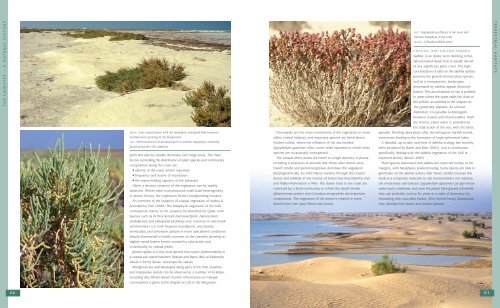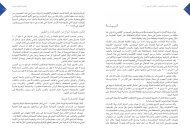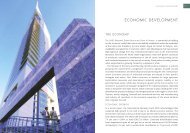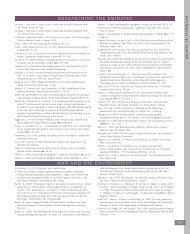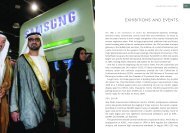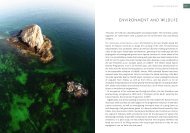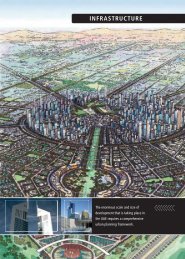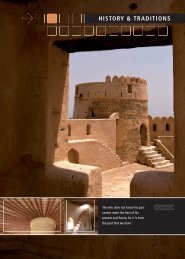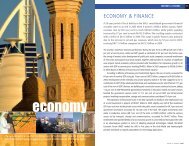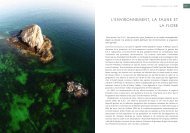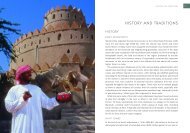TERRESTRIAL HABITATS - UAE Interact
TERRESTRIAL HABITATS - UAE Interact
TERRESTRIAL HABITATS - UAE Interact
You also want an ePaper? Increase the reach of your titles
YUMPU automatically turns print PDFs into web optimized ePapers that Google loves.
T H E E M I R A T E S – A N A T U R A L H I S T O R Y<br />
ABOVE: Low coastal dunes with the halophytic chenopod Halocnemum<br />
strobilaceum growing in the foreground.<br />
LEFT: Arthrocnemum macrostachyum is another halophyte commonly<br />
found along the <strong>UAE</strong> coastline.<br />
particular species usually dominate over large areas. The main<br />
factors controlling the distribution of plant species and community<br />
composition along the coast are:<br />
• salinity of the water and/or substrate<br />
• frequency and extent of inundation<br />
• the water-holding capacity of the substrate.<br />
Often, a distinct zonation of the vegetation can be readily<br />
observed. Where there is pronounced small-scale heterogeneity<br />
in abiotic factors, the vegetation forms corresponding mosaics.<br />
An overview of the zonation of coastal vegetation of Arabia is<br />
provided by Deil (2000). The halophytic vegetation of the <strong>UAE</strong><br />
corresponds mainly to the situation he describes for Qatar, with<br />
species such as Arthrocnemum macrostachyum, Halocnemum<br />
strobilaceum and Halopeplis perfoliata very common in salt-marsh<br />
environments (i.e. with frequent inundation), and Suaeda<br />
vermiculata and Limonium axillare in more specialised conditions.<br />
Salsola drummondii is locally common on the coastline, growing on<br />
slightly raised barrier berms created by tidal action and<br />
occasionally on coastal jebels.<br />
Juncus rigidus is a very local species that occurs predominantly in<br />
a coastal salt marsh between Dhayah and Rams (Ra’s al-Khaimah),<br />
where it forms dense, monospecific stands.<br />
Mangroves are well-developed along parts of the <strong>UAE</strong> coastline,<br />
and impressive stands can be observed at a number of localities,<br />
including Abu Dhabi Island. Further information on mangal<br />
communities is given in the chapter on Life in the Mangroves.<br />
Chenopods are the main constituents of the vegetation in more<br />
saline coastal habitats, and important species are listed above.<br />
Further inland, where the influence of the sea recedes,<br />
Zygophyllum qatarense often covers wide expanses in which other<br />
species are occasionally interspersed.<br />
The coastal white dunes are home to a high diversity of plants,<br />
including a profusion of annuals that thrive after winter rains.<br />
Dwarf shrubs and perennial grasses dominate the vegetation<br />
physiognomically. An informative transect through the coastal<br />
dunes and sabkhas in the vicinity of Dubai was described by Deil<br />
and Müller-Hohenstein (1996). The dunes close to the coast are<br />
colonised by a local community in which the dwarf shrubs<br />
Sphaerocoma aucheri and Cornulaca monacantha are important<br />
constituents. The vegetation of the dunes is treated in more<br />
detail below (see Sand Sheets and Dunes).<br />
LEFT: Halopeplis perfoliata is the most salttolerant<br />
halophyte in the <strong>UAE</strong>.<br />
BELOW: A flooded sabkha plain<br />
COASTAL AND INLAND SABKHA<br />
Sabkha is an Arabic term referring to flat,<br />
salt-encrusted desert that is usually devoid<br />
of any significant plant cover. The high<br />
concentration of salts on the sabkha surface<br />
prevents the growth of most plant species,<br />
and as a consequence, landscapes<br />
dominated by sabkha appear distinctly<br />
barren. This accumulation of salt is possible<br />
in areas where the water table lies close to<br />
the surface, as outlined in the chapter on<br />
The Quaternary Deposits. As a broad<br />
distinction, it is possible to distinguish<br />
between coastal and inland sabkha. With<br />
the former, saline water is provided by<br />
the tidal action of the sea, with the latter,<br />
episodic flooding takes place after the infrequent rainfall events,<br />
sometimes leading to the formation of large ephemeral lakes.<br />
A detailed, up-to-date overview of sabkha ecology has recently<br />
been produced by Barth and Böer (2002), and a contribution<br />
specifically dealing with the sabkha vegetation of the <strong>UAE</strong> is<br />
expected shortly (Brown 2005).<br />
Plant species associated with sabkha are restricted mainly to the<br />
margins, with halophytes predominating. Some plants are able to<br />
germinate on the sabkha surface after heavy rainfall, because this<br />
leads to a temporary reduction in salt concentrations. For instance,<br />
the moderately salt-tolerant Zygophyllum qatarense can germinate<br />
under such conditions, and once the plants have gained a foothold,<br />
they can probably survive for years in a state of dormancy by<br />
discarding their succulent leaves. After further heavy downpours,<br />
they develop new leaves and resume growth.<br />
T E R R E S T R I A L H A B I T A T S<br />
96<br />
97


